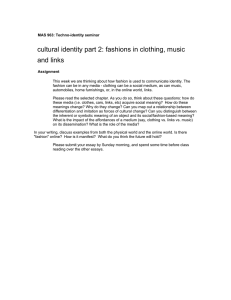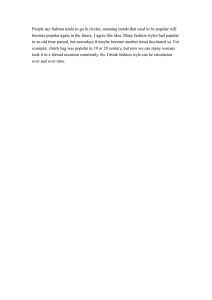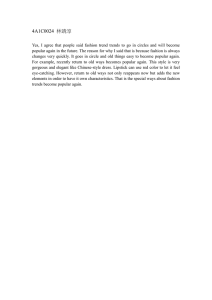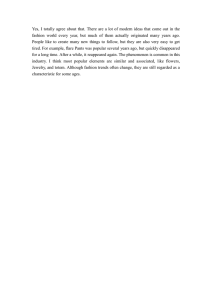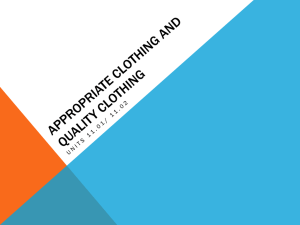______________________ forces Political forces Economic forces
advertisement
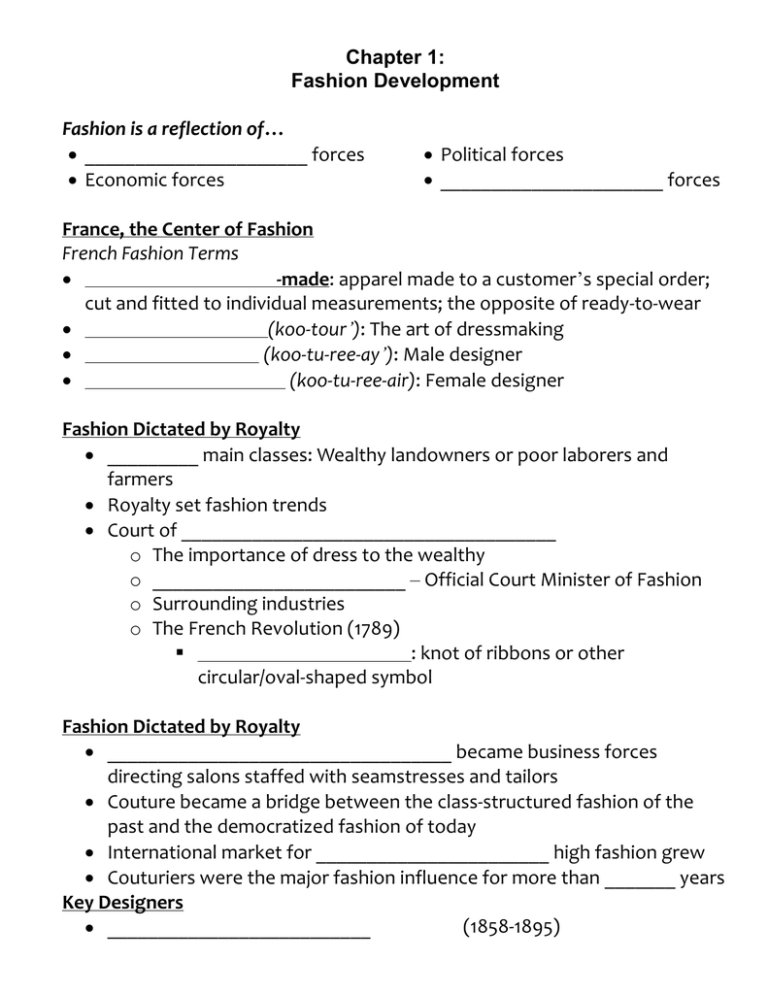
Chapter 1: Fashion Development Fashion is a reflection of… ______________________ forces Economic forces Political forces ______________________ forces France, the Center of Fashion French Fashion Terms -made: apparel made to a customer’s special order; cut and fitted to individual measurements; the opposite of ready-to-wear (koo-tour’): The art of dressmaking (koo-tu-ree-ay’): Male designer (koo-tu-ree-air): Female designer Fashion Dictated by Royalty _________ main classes: Wealthy landowners or poor laborers and farmers Royalty set fashion trends Court of _____________________________________ o The importance of dress to the wealthy o _________________________ – Official Court Minister of Fashion o Surrounding industries o The French Revolution (1789) : knot of ribbons or other circular/oval-shaped symbol Fashion Dictated by Royalty __________________________________ became business forces directing salons staffed with seamstresses and tailors Couture became a bridge between the class-structured fashion of the past and the democratized fashion of today International market for _______________________ high fashion grew Couturiers were the major fashion influence for more than _______ years Key Designers (1858-1895) __________________________ Jeanne Paquin (1912-1920) Madeleine Cheruit (1912-1923) __________________________ (1871-1920s) John Redfern (1850-1932;1936-1940) __________________________ (1920s-1952) Jeanne-Marie Lanvin (1909-today) Folk costume Arises from the underclass Very elaborate _______________________ (second-hand) clothing for special occasions were passed from one generation to another. o Varies with country and within the country o Distinguishes where you _________________________ from Industrial Revolution Inventions The Textile Industry o 1733 John Kay o 1789 Samuel Slater _________________ Immigrates from o 1764 James Hargreaves ________________ Spinning jenny with memorized machine plans o 1769 Richard Arkwright o 1814 Francis Cabot Lowell Water frame _________________ o 1785 Edmund Cartwright , integrated factory _________________ After the Civil War Textile industry relocated to the _________________, the source of cotton. Southern states also provided other incentives such as ________________________________. Eventually the South was the textile production center in the United States. Why the importance of the middle class? Late 18th Century (Post-Industrial Revolution): Extra money to spend Desire to demonstrate wealth o Fashion becomes a “_____________________________________” Desire to be perceived as respectable leads to development of the ______________________ Now able to influence fashion trends Establishment of the Business Suit Until ____________ men’s and women’s fashions had equal amounts of detail. Men’s clothing was custom-made by _________________ o Some _______________-made clothing was made in the 1700s in France o In America, tailors constructed ready-made suits for sailors for when they came on land o At first, tailors cut the fabrics and bundled the pieces and then sent them off to homes to be sewn by hand (_____________________________________ process) Tailors then became retailers with factory shops in seaport cities In 1818 New York- ________________________ started the men’s clothier business that became ________________________________ o Abraham Lincoln bought an overcoat for his second inauguration from Brooks Brothers. The Sewing Machine 1829 Barthelemy Thimmonier o __________________________________________ 1846 Elias Howe o ____________________________ (patented) 1859 Isaac Singer o _________________________ mass production Mass Production of Clothing ___________________________________o Opened a dry goods store in California after the gold rush o In ________, he began to manufacture long-wearing pants with riveted pockets that used a touch of cotton fabric called ______________________________ Civil War Uniforms- o The Union army recorded the ______________________________ measurements of over a million soldiers to come up with the first standardization of sizes (S, M, L, etc.) o After the war, sewing machines and uniform sizing promoted the mass production of everyday men’s wear. Women’s Fashions and Social Changes Rigid differences between the roles of the sexes. Women: o Constraining garments characteristic of their restricted lifestyles and obedience to their husbands and fathers. o No right to own anything except their clothing 3 basic garments for women Women’s Separates Mass Production Separates were introduced in the __________________ Hemlines and waistlines were easily adjusted o Making it possible for the working- or middle-class women to add a variety to her wardrobe by mixing separates _________________________________________-illustrator in the 1890s 19th Century Retailing Traveling merchants brought clothes to fairs and ______________________. o Expensive items were only shown to the wealthy o Prices were not marked; you could bargain your way to a good price 2 types of stores: o ____________________________________ Stores o Specialty Stores The Department Store 1826: Samuel ____________ and George Washington _______________ opened the first ____________________________ store in NYC ____________________________ (New York) Harrod’s of London, 1849, established by Henry Harrod o Started as a small grocery store o _____________, 100 employees and became the largest department store Early Mail-Order Merchandising 1800s, ____________ of the population lived in rural areas Satisfaction guaranteed or your money back o _____________________________________________________ 1886, Richard Sears o _____________________________________________________ The First Fashion Magazines Communications: o Fashion Magazines ____________________________________ -1867 ____________________ - 1894 What is the effect? o Women become aware of new styles o Desire to wear new styles ____________________ o Rate of fashion change ______________________ o The demand for more new looks ______________________ Growth of Leisure Activities Sports participation o _______________________ specific apparel is needed Bicycling Swimming Horse-riding o Swimwear becomes practical o Pants for women- ____________________________________ Garment Industry Growth New York City o Immigrants with skills, need job o __________________________________: hours, conditions, wages o 1914 Amalgamated Clothing Workers of America _______ hour week 1911 Triangle Shirtwaist Factory Fire o __________ deaths o Public indignation o Better ______________________ conditions World War I ___________________ America entered the war Women start to enter workforce, need appropriate clothing A trend towards ____________________________ in women’s fashion emerged WWI factory work leads to increased practicality in clothing o ________________________ discarded o Hemlines rise o Skirts _______________________ Designers of the Era Paul Poiret o _________________________________________ Gabrielle “Coco” Chanel o The ____________________ look Jean Patou o The ____________________ look Retail Expansion in the Early 20th Century Early 20th century o Bergdorf Goodman and _______________________________in New York and Nieman Marcus in Dallas concentrated on solely the finest fashion and ________________________________________ 1900’s o ________________________________ enters retailing as an owner 1920’s o Suburban Retail Centers 1930’s o First ___________________________ as presidents of retail firms o Dorothy Shaver (Lord & Taylor) mentions American designers in ads The Depression and Fashion First, a look at what is happening o 12.8 million are unemployed o 50% of banks fail o _______% of garment factories fail An escape from reality: _________________________________ o Americans attend films 1-2 times a week o See __________________________ fashions o Gilbert Adrian leading _________________ designer Important Designers Elsa Schiaparelli o ____________________________ interest o Trendsetter of the 1930s James Mainbocher o First successful ____________________________ designer in Europe o Wedding dress for ___________________________________ World War II Closure of __________________________ design houses American designers come to forefront Wartime _______________________________ Fashion is stable Claire McCardell: The _____________________________ Look Postwar Fashion Population migration and the ____________________________ o Emphasis on home and casual clothes Retailers move to suburbs: the Mall o Finding fashion faster o ______________________________________ Christian Dior: _______________________________ Christobal Balenciaga: the master of tailors Influential: o Jacqueline Kennedy o _________________________________ The Youthful 1960s British Influences o Mary Quant o Zandra Rhodes o Jean Muir The “ _________________” look ____________________________________ Increased interest in men’s fashion Youthfulness had negative effect on couture Revival of Men’s Fashion English Mod look affected men’s fashion Men became more concerned with their roles outside work and with leisure dressing Pierre Cardin o Contract for men’s shirts and ties in 1959 o ________________________________________ department store Fashion Business and Retailing 1960s saw the last _________________________ fashion for 20 years o Small, family owned fashion businesses closed Some merged or were purchased by large corporations Some flourished with the economy through stocks Boutiques grew in population o ___________________________________ opened his first boutique o Boutiques brought a freshness to retailing 1970’s Ethnic and Folk looks predominate Physical fitness fashion Women go to work and __________________________________ begins Preppy Look and designer jeans ________________________, Halston, Geoffrey Beene, Ralph Lauren, Mary Mc Fadden 1980’s Consolidation among manufacturers and retailers Still dressing for success: the ‘_________________________’ Influential designers o _________________________ (Milan) o Takada (Japan) o Miyake (Japan) Lady Diana Spenser International recognition for American Designers o Calvin Klein 1980’s Industry Trends Use of ____________: Growth of designer and brand names through licensing Overstored America Growth of mail order/catalogs 1990’s Value orientation of consumers o _______________________________ Retailers consolidate, enter into bankruptcy ____________________________ affects imports Grunge Look is an anti-fashion statement Menswear market seeks tremendous growth The 21st Century Competition is tougher more than ever Fashion can be the same all over the world _________________________________________ are the fashion leaders American consumers are buying fewer pieces of clothing Imports are increasing (___________________) Retail mergers continue
